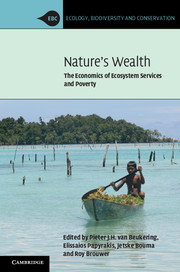Book contents
- Frontmatter
- Contents
- List of contributors
- Acknowledgements
- 1 The economics of ecosystem services and poverty
- Part I Biodiversity-related ecosystem services
- Part II Marine-related ecosystem services
- Part III Forest-related ecosystem services
- 8 Greening the charcoal chain in Tanzania
- 9 Payments for environmental services in the protected areas of the Philippines
- 10 The copper curse and forest degradation in Zambia
- 11 Institutions and forest management in the Swat region of Pakistan
- Part IV Water-related ecosystem services
- Part V Land-related ecosystem services
- Index
- References
9 - Payments for environmental services in the protected areas of the Philippines
Published online by Cambridge University Press: 05 July 2013
- Frontmatter
- Contents
- List of contributors
- Acknowledgements
- 1 The economics of ecosystem services and poverty
- Part I Biodiversity-related ecosystem services
- Part II Marine-related ecosystem services
- Part III Forest-related ecosystem services
- 8 Greening the charcoal chain in Tanzania
- 9 Payments for environmental services in the protected areas of the Philippines
- 10 The copper curse and forest degradation in Zambia
- 11 Institutions and forest management in the Swat region of Pakistan
- Part IV Water-related ecosystem services
- Part V Land-related ecosystem services
- Index
- References
Summary
Introduction
Few fathers will hesitate to chop down a tree if this helps to pay for the education of their children, even though they know that this might hurt them in the long run. Neither is it much of a choice when existing plots of farmland become unproductive, and a farmer can either let his family go hungry, or create a new plot by burning down a patch of forest. Considering these ‘choices’, it is no surprise that the forest and farming practices of the poor forest and mountain communities have been the main causes of forest depletion in the Philippines.
The Philippine forests are home to a large, marginalized sector of society composed of both migrant and indigenous dwellers. They constitute about 20 million or 25% of the total population and are generally considered the poorest of the poor. The relationship between poverty and forest degradation is not always the same and there are some poor forest communities that invest considerable time and resources in sustainable forest management practices while trying to meet their basic needs. In many cases, however, these communities’ dependence on the forests results in the degradation of the resources they need for their livelihood and survival.
- Type
- Chapter
- Information
- Nature's WealthThe Economics of Ecosystem Services and Poverty, pp. 201 - 216Publisher: Cambridge University PressPrint publication year: 2013



